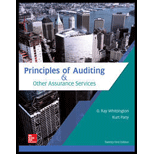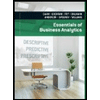
Principles Of Auditing & Other Assurance Services
21st Edition
ISBN: 9781259916984
Author: WHITTINGTON, Ray, Pany, Kurt
Publisher: Mcgraw-hill Education,
expand_more
expand_more
format_list_bulleted
Question
Chapter 9, Problem 36QRA
To determine
Calculate the
Expert Solution & Answer
Want to see the full answer?
Check out a sample textbook solution
Students have asked these similar questions
PLEASE HELP
One company might depreciate a new computer over three years while another company might depreciate the same model computer over five years...and both companies are right.
True
False
no chatgpAccumulated Depreciation will appear as a deduction within the section of the balance sheet labeled as Property, Plant and Equipment.
True
False
Chapter 9 Solutions
Principles Of Auditing & Other Assurance Services
Ch. 9 - Prob. 1RQCh. 9 - Prob. 2RQCh. 9 - Prob. 3RQCh. 9 - Prob. 4RQCh. 9 - Prob. 5RQCh. 9 - Prob. 6RQCh. 9 - Prob. 7RQCh. 9 - Prob. 8RQCh. 9 - Prob. 9RQCh. 9 - Prob. 10RQ
Ch. 9 - Prob. 11RQCh. 9 - Prob. 12RQCh. 9 - What is a dual-purpose test?Ch. 9 - Prob. 14RQCh. 9 - Prob. 15RQCh. 9 - Prob. 16RQCh. 9 - What would be the difference between an attributes...Ch. 9 - Prob. 18RQCh. 9 - Prob. 19RQCh. 9 - Prob. 20RQCh. 9 - Prob. 21RQCh. 9 - Prob. 22RQCh. 9 - Prob. 23RQCh. 9 - Prob. 24RQCh. 9 - Prob. 25RQCh. 9 - Prob. 26RQCh. 9 - Prob. 27RQCh. 9 - Prob. 28RQCh. 9 - Prob. 29QRACh. 9 - Prob. 30QRACh. 9 - Prob. 31QRACh. 9 - Prob. 32QRACh. 9 - Prob. 33QRACh. 9 - Prob. 34QRACh. 9 - Prob. 35QRACh. 9 - Prob. 36QRACh. 9 - Prob. 37AOQCh. 9 - Prob. 37BOQCh. 9 - Prob. 37COQCh. 9 - Prob. 37DOQCh. 9 - Prob. 37EOQCh. 9 - Prob. 37FOQCh. 9 - Prob. 37GOQCh. 9 - Prob. 37HOQCh. 9 - Prob. 37IOQCh. 9 - Prob. 37JOQCh. 9 - Prob. 37KOQCh. 9 - Prob. 37LOQCh. 9 - Prob. 38OQCh. 9 - Prob. 39OQCh. 9 - For each term in the first column below, identify...Ch. 9 - Prob. 41OQCh. 9 - Smith, Inc. Rachel Robertson wishes to use...Ch. 9 - Prob. 43OQCh. 9 - Prob. 44PCh. 9 - Prob. 45PCh. 9 - Prob. 46PCh. 9 - Prob. 47PCh. 9 - In the audit of Potomac Mills, the auditors wish...Ch. 9 - Prob. 49PCh. 9 - Prob. 50PCh. 9 - Prob. 51PCh. 9 - Prob. 52ITC
Knowledge Booster
Similar questions
- No ai Depreciation Expense is shown on the income statement in order to achieve accounting's matching principle. True Falsearrow_forwardno aiOne company might depreciate a new computer over three years while another company might depreciate the same model computer over five years...and both companies are right. True Falsearrow_forwardno ai An asset's useful life is the same as its physical life? True Falsearrow_forward
- no ai Depreciation Expense reflects an allocation of an asset's original cost rather than an allocation based on the economic value that is being consumed. True Falsearrow_forwardThe purpose of depreciation is to have the balance sheet report the current value of an asset. True Falsearrow_forwardDepreciation Expense shown on a company's income statement must be the same amount as the depreciation expense on the company's income tax return. True Falsearrow_forward
arrow_back_ios
SEE MORE QUESTIONS
arrow_forward_ios
Recommended textbooks for you
 Auditing: A Risk Based-Approach (MindTap Course L...AccountingISBN:9781337619455Author:Karla M Johnstone, Audrey A. Gramling, Larry E. RittenbergPublisher:Cengage Learning
Auditing: A Risk Based-Approach (MindTap Course L...AccountingISBN:9781337619455Author:Karla M Johnstone, Audrey A. Gramling, Larry E. RittenbergPublisher:Cengage Learning Essentials Of Business AnalyticsStatisticsISBN:9781285187273Author:Camm, Jeff.Publisher:Cengage Learning,
Essentials Of Business AnalyticsStatisticsISBN:9781285187273Author:Camm, Jeff.Publisher:Cengage Learning, Essentials of Business Analytics (MindTap Course ...StatisticsISBN:9781305627734Author:Jeffrey D. Camm, James J. Cochran, Michael J. Fry, Jeffrey W. Ohlmann, David R. AndersonPublisher:Cengage Learning
Essentials of Business Analytics (MindTap Course ...StatisticsISBN:9781305627734Author:Jeffrey D. Camm, James J. Cochran, Michael J. Fry, Jeffrey W. Ohlmann, David R. AndersonPublisher:Cengage Learning Auditing: A Risk Based-Approach to Conducting a Q...AccountingISBN:9781305080577Author:Karla M Johnstone, Audrey A. Gramling, Larry E. RittenbergPublisher:South-Western College Pub
Auditing: A Risk Based-Approach to Conducting a Q...AccountingISBN:9781305080577Author:Karla M Johnstone, Audrey A. Gramling, Larry E. RittenbergPublisher:South-Western College Pub

Auditing: A Risk Based-Approach (MindTap Course L...
Accounting
ISBN:9781337619455
Author:Karla M Johnstone, Audrey A. Gramling, Larry E. Rittenberg
Publisher:Cengage Learning

Essentials Of Business Analytics
Statistics
ISBN:9781285187273
Author:Camm, Jeff.
Publisher:Cengage Learning,

Essentials of Business Analytics (MindTap Course ...
Statistics
ISBN:9781305627734
Author:Jeffrey D. Camm, James J. Cochran, Michael J. Fry, Jeffrey W. Ohlmann, David R. Anderson
Publisher:Cengage Learning

Auditing: A Risk Based-Approach to Conducting a Q...
Accounting
ISBN:9781305080577
Author:Karla M Johnstone, Audrey A. Gramling, Larry E. Rittenberg
Publisher:South-Western College Pub